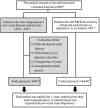Increased risk of major depression in the three years following a femoral neck fracture--a national population-based follow-up study
- PMID: 24626193
- PMCID: PMC3953077
- DOI: 10.1371/journal.pone.0089867
Increased risk of major depression in the three years following a femoral neck fracture--a national population-based follow-up study
Abstract
Femoral neck fracture is common in the elderly, and its impact has increased in aging societies. Comorbidities, poor levels of activity and pain may contribute to the development of depression, but these factors have not been well addressed. This study aims to investigate the frequency and risk of major depression after a femoral neck fracture using a nationwide population-based study. The Taiwan Longitudinal Health Insurance Database was used in this study. A total of 4,547 patients who were hospitalized for femoral neck fracture within 2003 to 2007 were recruited as a study group; 13,641 matched non-fracture participants were enrolled as a comparison group. Each patient was prospectively followed for 3 years to monitor the occurrence of major depression. Cox proportional-hazards models were used to compute the risk of major depression between members of the study and comparison group after adjusting for residence and socio-demographic characteristics. The most common physical comorbidities that were present after the fracture were also analyzed. The incidences of major depression were 1.2% (n = 55) and 0.7% (n = 95) in the study and comparison groups, respectively. The stratified Cox proportional analysis showed a covariate-adjusted hazard ratio of major depression among patients with femoral neck fracture that was 1.82 times greater (95% CI, 1.30-2.53) than that of the comparison group. Most major depressive episodes (34.5%) presented within the first 200 days following the fracture. In conclusion, patients with a femoral neck fracture are at an increased risk of subsequent major depression. Most importantly, major depressive episodes mainly occurred within the first 200 days following the fracture.
Conflict of interest statement
Figures



References
-
- Cannada LK, Viehe T, Cates CA, Norris RJ, Zura RD, et al. (2009) A retrospective review of high-energy femoral neck-shaft fractures. J Orthop Trauma 23: 254–260. - PubMed
-
- Wolinsky PR, Johnson KD (1995) Ipsilateral femoral neck and shaft fractures. Clin Orthop Relat Res (318): 81–90. - PubMed
-
- Alho A (1997) Concurrent ipsilateral fractures of the hip and shaft of the femur. A systematic review of 722 cases. Ann Chir Gynaecol 86: 326–336. - PubMed
-
- Miyanishi K, Jingushi S, Torisu T (2010) Mortality after hip fracture in japan: The role of nutritional status. J Orthop Surg (Hong Kong) 18: 265–270. - PubMed
Publication types
MeSH terms
LinkOut - more resources
Full Text Sources
Other Literature Sources
Medical

